If you don’t have the time to read through this article, then the difference between the 35mm vs 50mm vs 85mm focal lengths boils down to use cases:
- If you want a wider lens that captures more of the background to tell a story with it, go for a 35mm.
- If you want to isolate your subject and have the ability to blur the background as much as possible, go for an 85mm lens.
- If you want the cheapest prime lens that is also the middle ground between the 35mm and the 85mm, then go for a 50mm lens.
Most serious photographers have at least one of these focal lengths in their kit, if not all of them. The 50mm is considered to be the middle ground lens, which closely resembles the angle of view of the human eye. The 85mm is more focused (zoomed in) than the 50mm, making it a good choice for portraits. The 35mm, on the other hand, has a wider field of view, thus making it a great all-rounder.
You will find photographers that swear by each of these lenses and consider them the best solution, but that is all about personal preference. This article aims to inform you what you can expect from each focal length and then make an informed decision for the next addition to your photography kit.
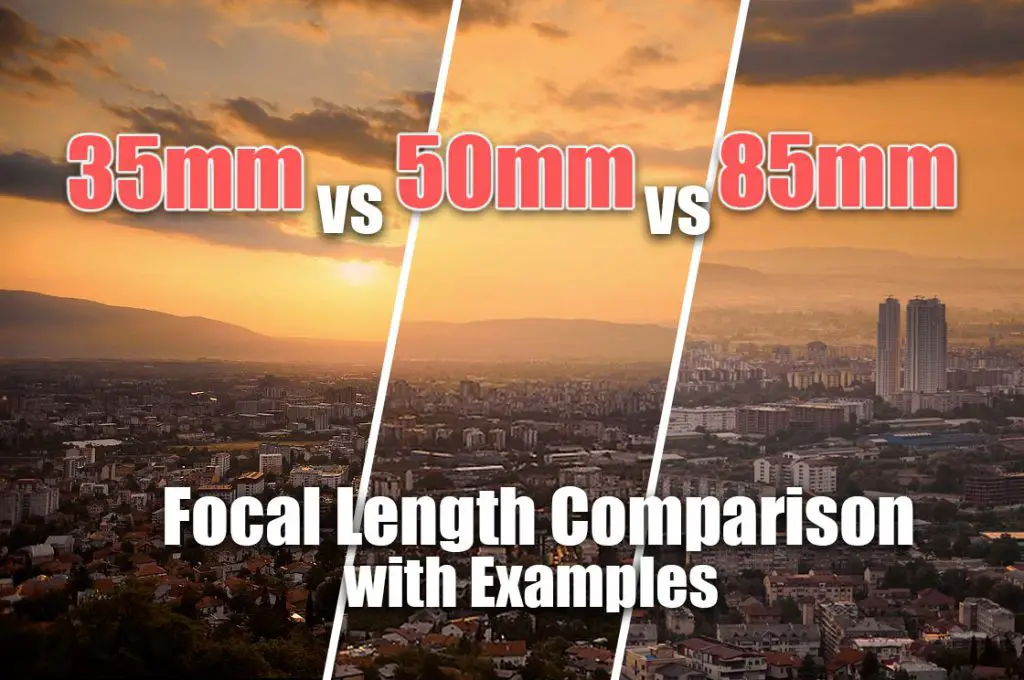
What is a 35mm lens good for?
The 35mm lens is the widest one of the bunch. This gives you plenty of opportunities to use that to your advantage. Even though it will not give you as much background separation as an 85mm lens, a 35mm lens is great for environmental portraits, group portraits, weddings, or even lifestyle. And it works great for landscapes too.
The 35mm lens works great for everything you would normally see with your own eyes. Even though the 50mm is considered to be the focal length closest to the human eye, while that might be true, we have two eyes. Pair two 50mm lenses, one next to another with the overlap our eyes have, and you will get something closer to a 35mm field of view without it being 3D.
For that reason, many photographers use the 35mm when they want to achieve a natural look. Environmental portraits, for example, work great as they give the viewer the feeling as if they are there. You can not really achieve that with an 85mm. Our eyes do not see that much background separation.
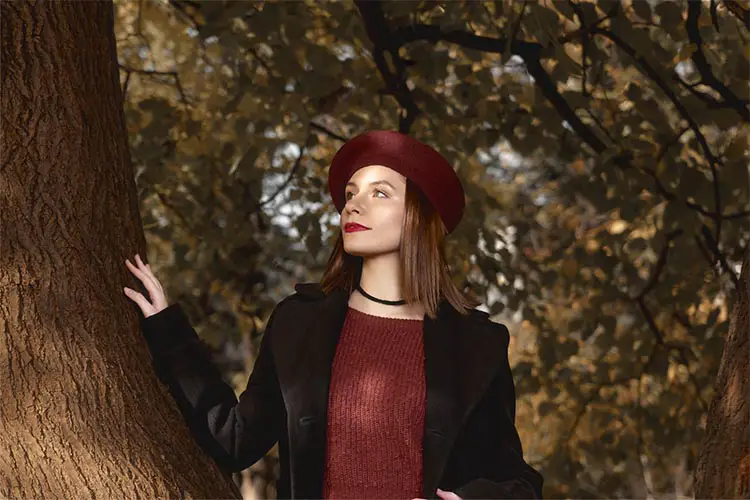
Weddings are a great place to use a 35mm lens since this is where the same angle of view works great as well. If the 35 mm works for weddings, it will work for most of the ceremonies as well. Baptisms, Bar Mitzvahs, Graduation ceremonies, and so forth.
Many lifestyle and travel photographers shoot with a 35mm, and if I were a lifestyle photographer, I would go the same route. It is not too wide, so it doesn’t look as distorted and weird as a 20mm lens would look, and yet it is wide enough to capture everything necessary with a pleasing background blur. The 50mm or 85mm lens would be harder to manage since you would often work in tight places. The 85mm would compress the background a bit too much in this case.
Landscapes and street photography are also good genres for the 35mm lens to shine. The natural angle of view of the 35 makes it an excellent choice for street photography. If you are brave enough to get closer to the subject, the 35mm will provide you with a great street photo that will border an environmental portrait-like look.
Landscapes, though, will not be as wide as you might like. A 35mm will provide a more selective composition than an ultrawide would. But that is not a bad thing. Often a bit of a selective view works great.
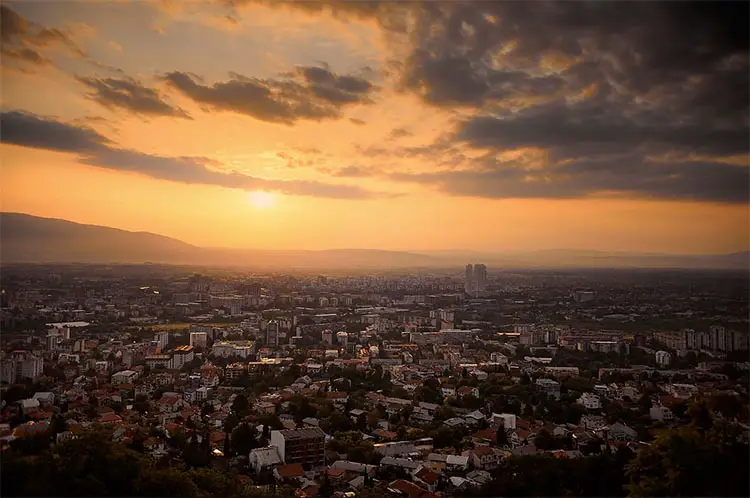
Read More:
How to use a 35mm lens?
Low light performance
A 35mm, being a prime lens, will offer you wide apertures. Among the three lenses we discuss here, it has the widest focal length. That means in low light scenarios, you can use a shutter speed of around 1/60th of a second if you follow the reciprocal rule. Pair that with f/2 or wider, and you have a decent recipe for good low light performance. Compared to the 50mm and 85mm on the same aperture and ISO, the 35mm would be ⅔ and 1 ⅓ stops brighter, respectively.
Note that in this case, the reciprocal rule states 1/35th shutter. But we double that to be on track with modern times. Modern cameras have sensors with high pixel densities. Therefore, the reciprocal rule is not as safe as it used to be. That is why doubling it is the way to go. Canon cameras allow you to set the auto shutter speed to be roughly twice the focal length. If they do it, probably we should do it too.
Composition
At this focal length you have to be quite aware of your surroundings. You can not avoid the background, nor can you wash it out entirely in background blur. Sure, for extreme close-ups at a wide aperture, you can. But, at 35mm, you will be using the background in a more obvious manner, so it can aid your photo.
With that, you should think about your composition a bit more. You will have to plan your composition with your subject and background in tandem. The background will have to add to the subject instead of it being just a cool backdrop.
Aperture
Same as any other lens, the aperture plays a vital role in the final look of your photo. The aperture does not just control the amount of light. It also controls the background blur.
If your distance to the subject is near or exceeding 5 meters, you will get very little background blur when wide open. If the amount of light is not an issue, you might want to consider closing down the aperture. That way, you will actually have everything in focus.
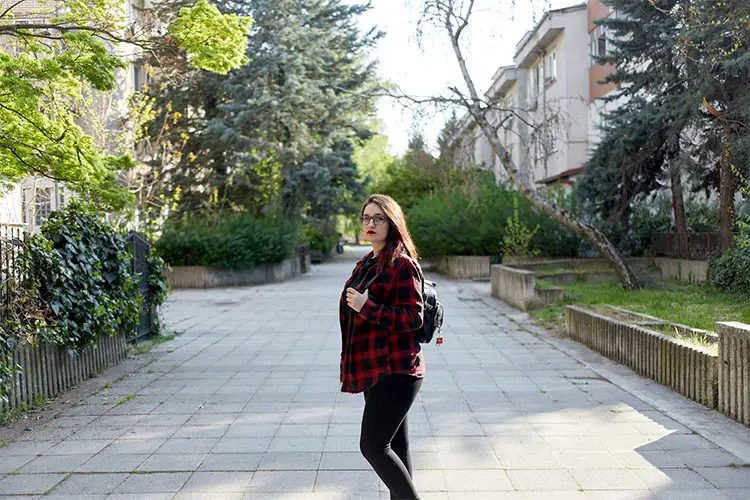
This way, you separate your subject from the background using light, color, contrast, and other tools and have the background sharp to aid your photo.
What is a 50mm lens used for?
Since the golden age of film, the fifty is considered to be the lens that everyone should have. Most film cameras came with a 50mm lens as a kit. That doesn’t mean that the 50mm is the most versatile lens, far from it. No lens can do it all. However, it seems that it is the easiest lens to design. Therefore there are plenty of variations out there.
All that is great, but why should you use one? Well, the 50mm is a great all-around lens, with some limitations.
I mentioned environmental portraits when I discussed the 35mm lens. The 50mm lens is great for that scenario too. It will be slightly more limiting if you are working in tight spaces, but you will have the benefit of zero distortion and the natural look and feel of the portrait. At this point, it is a matter of personal preference and taste.
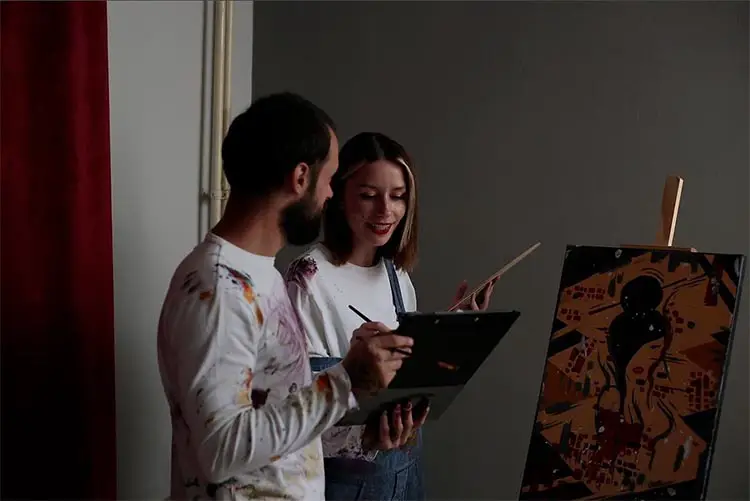
The 50mm lens is a great all-around portrait lens. Most portrait photographers have it in their bags. It provides enough subject separation and blurry background when wide open, even for a full-body shot. And since you will have to have a bit more distance to the subject than the 35mm, you will have less exaggeration of the facial features.
It is a great choice for weddings and similar events too. Yes, that is also where the 35mm shines. However, the 50mm proves great for the important moments where you want to single out someone. For example, it will work great for the first dance, walking down the aisle, saying the marriage vows, and so forth. This applies to other ceremonies too, where you have to photograph people of importance.
If we were to ask Henri Cartier-Bresson how to shoot street photography, he would say that a 35mm rangefinder Leica with a 50mm lens is the way to go. At least that was what he was famous for. Make no mistake, the 50mm is an excellent street photography tool. It gives you a bit more distance to the subject than the 35mm lens, thus allowing you to shoot unnoticed.
You can go for landscapes with a 50mm lens too. Landscapes are the most flexible when it comes to lenses. All you need to do is figure out what you want to shoot. A 50mm lens will force you to pick your composition more precisely, and you will be going for details instead of a whole vista.
Read More:
How to use a 50mm lens?
Low light scenarios
Just like the 35mm lens, the 50mm is excellent in low light. Wide aperture 50mm lenses are quite cheap. That means you can get into low-light photography on a budget. An f/1.8 50mm lens costs around $125 if you shoot Canon or $215 if you shoot Nikon. If you want to go to f/1.4 aperture, then you are looking at around a $400-500 price tag. Which is not that bad.
That said, unlike the 1/60th of a second minimum shutter speed you can achieve with the 35mm lens, with the 50mm, you will be using 1/100th of a second. Which is ⅔ of a stop darker. Now, that difference is not that bad in reality since it is still a great low-light performer.
Composition
In regards to composition with the 50mm, you still need to be more aware of your surroundings, just like the 35mm. However, you have a bit more flexibility here. The 50mm provides you with more background blur, and it compresses the background more when compared to the 35mm. That allows you to get away with a subpar background easier. It doesn’t mean that you should. It means that if you don’t have a choice, you can.
Even though the 50mm creates more subject to background separation, stepping back a couple of steps can negate that if you need it. That means that you have the option to separate your subject from the background via background blur or blend it with the background if you don’t want background blur. You have the flexibility to do so.
Aperture and Depth of Field
With the 50mm, the aperture plays a vital role in your composition. Wide-open it separates your subject from the background most of the time. However, if you stop it down a little, it behaves a bit more like a 35mm lens.
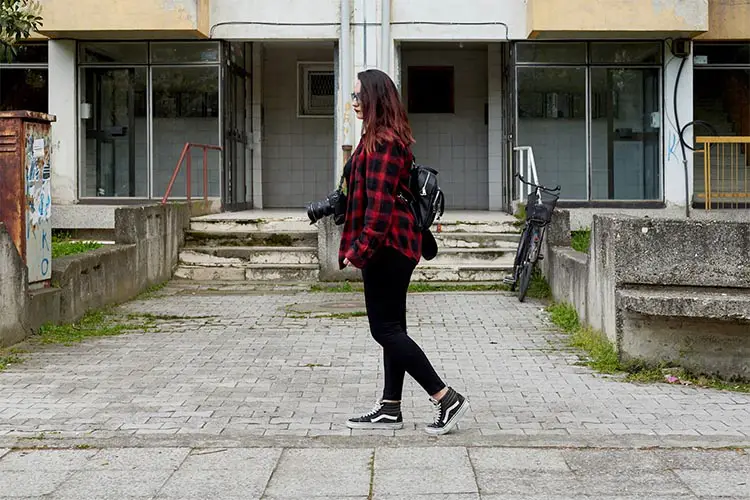
For example, stop it down to f/4 and move away from your subject around 5 meters, and your background will be mostly in focus. At f/6.3 and above, pretty much everything is in focus at a distance of 4+ meters.
If you were to do a close-up portrait at a smaller aperture, say f/3.5, you would still get a decent amount of background blur.
What is an 85mm lens used for?
If you want to focus on the subject and reduce the background to creamy blurriness, the 85mm lens is what you should go for. Generally, the 85mm compresses the background the most when compared to the 35mm and the 50mm lenses. That means the use cases for 85mm lenses fall more towards subject separation.
For portrait use, the 85mm is great for beauty shots, fashion photography, and pretty much all commercial portrait photography. Environmental photos can be done, but they are quite hard to pull off in tight spaces.
Street photography with the 85mm is cool too. With a lens of this focal length, you will be doing more candid shots because you will have the distance to the subject to do so. Being less conspicuous allows you to grab shots that you wouldn’t be able to do with a 35mm lens.
The 85mm is quite useful for landscapes as well. When you want to point the attention towards a specific segment of the landscape, grabbing an 85mm lens would be quite useful.
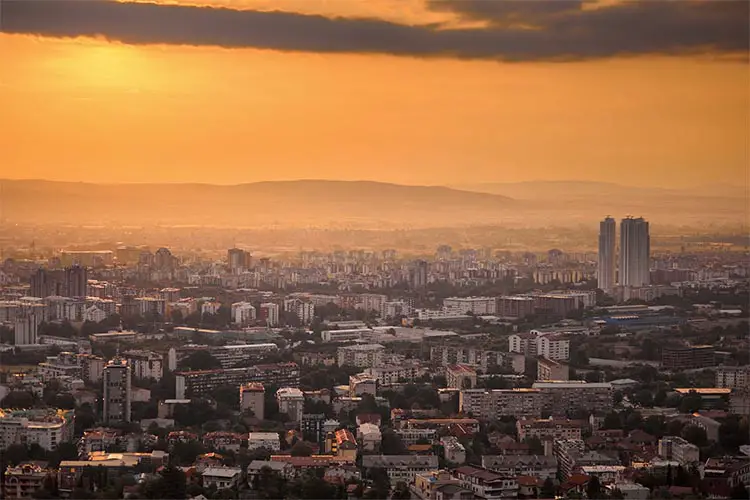
When you are shooting weddings and celebrations, the 85mm lens is great for candid shots and portraits of the bride and groom. Especially if you are doing a full wedding package, the photoshoot and preparations before the wedding look great with an 85mm lens.
How to use an 85mm lens?
Unlike the 35mm and 50mm lenses, you will have to adjust your shooting style a bit with the 85mm lens. The distance to the subject can affect your communication on photoshoots, or it can make it harder to get a clean shot in street photography scenarios. You will have to exercise patience.
Low light performance
The double of the reciprocal rule for the 85mm lens is a shutter speed of around 1/160th. For the same settings, this means that the 85mm lens is ⅔ of a stop darker than the 50mm, and another ⅔ of a stop than the 35mm.
That being said, being a prime lens puts it an advantage over zoom lenses with the same focal distance. Especially at the same price point, it will compete with zoom lenses like the 70-300mm ones, which often have apertures starting from f/4 and above.
Being slightly darker due to shutter speed limitations does not mean that it is not a good lens for low light. I have shot my 85mm f/1.8 in low light a lot. It works great, even on cameras with poor ISO performance.
Composition
The 85mm lens is the most forgiving in composition when compared to the 50mm and 35mm lenses. That means that subpar backgrounds can be easily used since they will be washed out in background blur, especially for close-ups. At this point, especially wide open, with an 85mm lens portraits and street photos where the subject fills the frame, the background isn’t that important.
Of course, this does not mean that you need to disregard the background completely. But, you can make a lot more compromises than you would with a 35mm lens.
Even with full-body shots at f/2, the background is still quite blurry. Meaning that the subject is quite separated from it.
Aperture and Depth of FIeld
Shooting this lens wide open will blur the background significantly. If you are shooting an f/1.4 lens, you should be careful when shooting wide open, particularly if taking a portrait. In this case, you have a field of focus which is roughly 1cm. So, if your focus is slightly off, the portrait will be soft or improperly focussed.
To mitigate this, you can close down the aperture a bit, somewhere in the range of f/2 or f/2.8. That way, you are respectively doubling and tripling the field of focus size. Which will increase your odds of having a photo focussed correctly.
For a classic portrait, at f/1.4, if you miss focus on the eye and the camera focuses on the nose, the eye will be completely blurry.
50mm vs 85mm for Street Photography
Comparing the 50mm and 85mm lenses for street photography isn’t as straightforward as it seems. On paper, the differences between the 50mm and 85mm should somewhat mirror the differences between the 35mm and 50mm for street photography.
However, street photography is all about flexibility and the ability to capture things quickly. With the 85mm, that gets a bit difficult.
Composition and angle of view
Akin to the 35mm vs 50mm comparison, if you were to keep the subject the same between the 50mm and 85mm lenses, the 50mm would capture more of the background.
In this case, the 85mm does not do the background justice. Even though it is clear that the girl is photographing buildings in both photos on the photo shot with the 85mm, we can not judge the scale of the buildings.
It is not obvious whether the buildings are highrises or regular 10-15 story apartment buildings. On the 50mm shot, it is still discernable that the buildings are highrises.
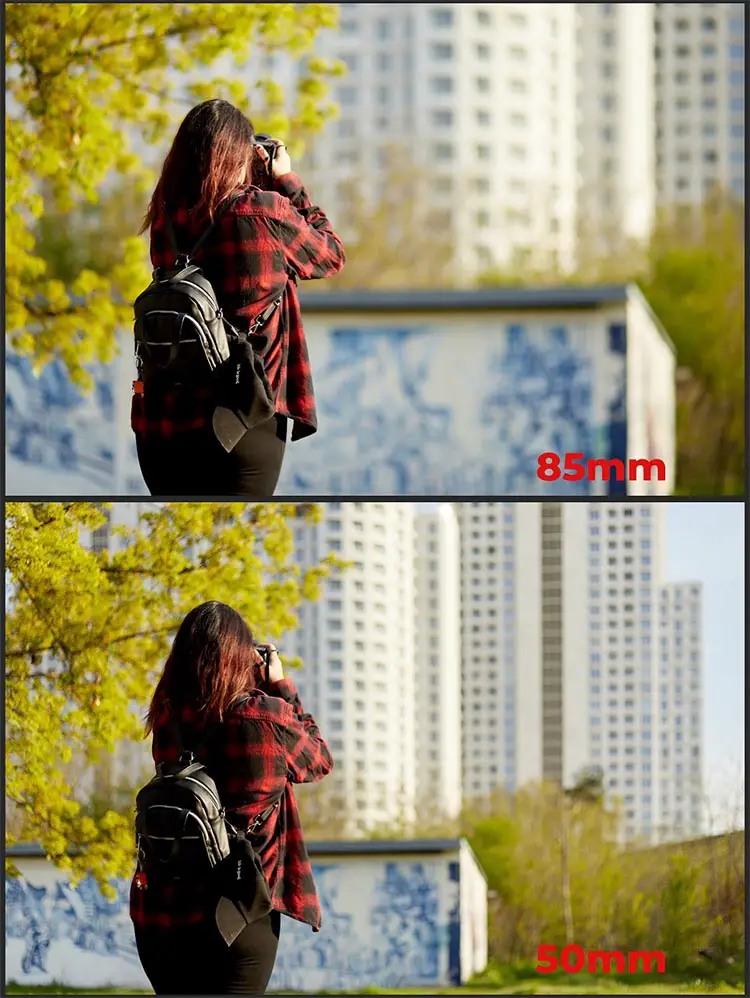
There are instances where a telephoto lens like the 85mm one can find its purpose in street photography. When you want to reduce clutter in the scene and have a more selective background, an 85mm lens might be the right tool for it.
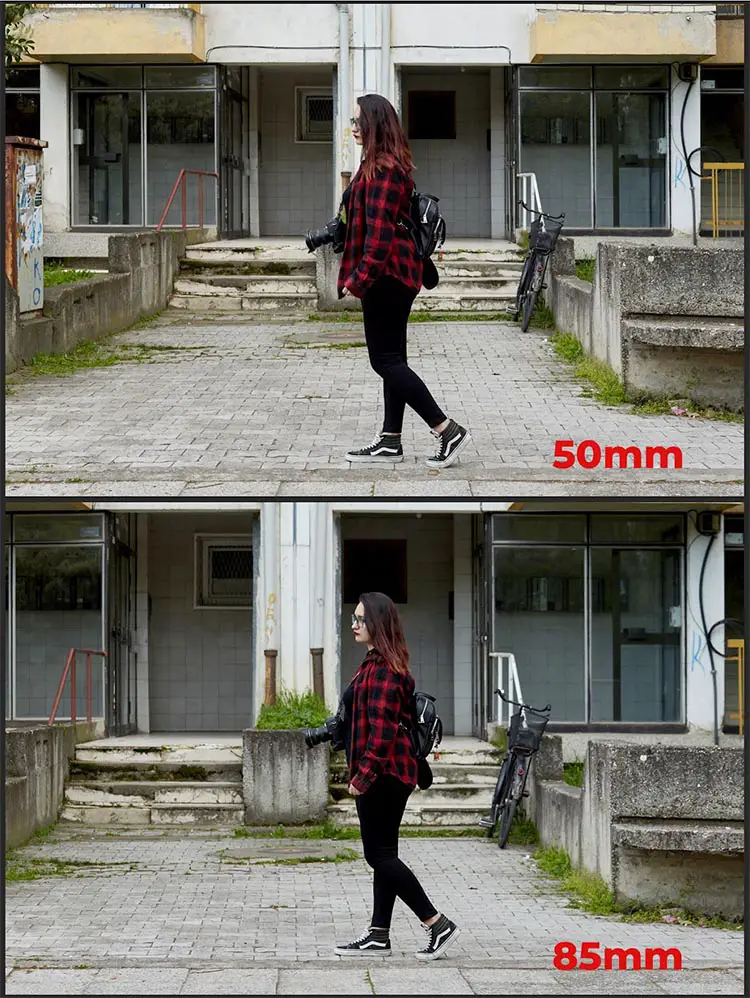
Ease of use
In this case, as well, both lenses are easy to use. Fast primes. Here too, there are pros and cons for each focal length.
It is easier to frame up a shot with the 50mm since you are closer to the subject. With the 85mm, you are quite far, allowing for people to pass by and ruin your shot.
On the other hand, if you need to be candid, the 85mm will provide you with a greater distance to the subject, making you even more inconspicuous. That might lead to more successful photos or photos with less human interaction. Again, this depends on the culture you live in.
With the 85mm, you might find yourself in situations where the background is too blurry, and you need to close down the lens. In a low-light situation, that might be a deal-breaker.
So, I would say that a 50mm is a better all-rounder lens, while the 85mm is a bit harder to use but can provide cool results in certain circumstances.
Ergonomics
85mm lenses are often larger than the 50mm lenses. Not by a large margin, but still larger. This means that they are a bit heavier too. However, the difference isn’t too significant, and with that, the ergonomics are quite similar.
50mm vs 85mm for Portraits
For portraiture, the 50mm and 85mm overlap quite often as they both fall on the telephoto end. Both are great portrait lenses. However, they have unique characteristics, which can be useful depending on the scenario.
Background compression and exaggeration
If I were to perform the same comparison between the 50mm and 85mm as I did with the 35mm and 50mm, where the subject is the same size in the frame between the two lenses, the result would look like this:
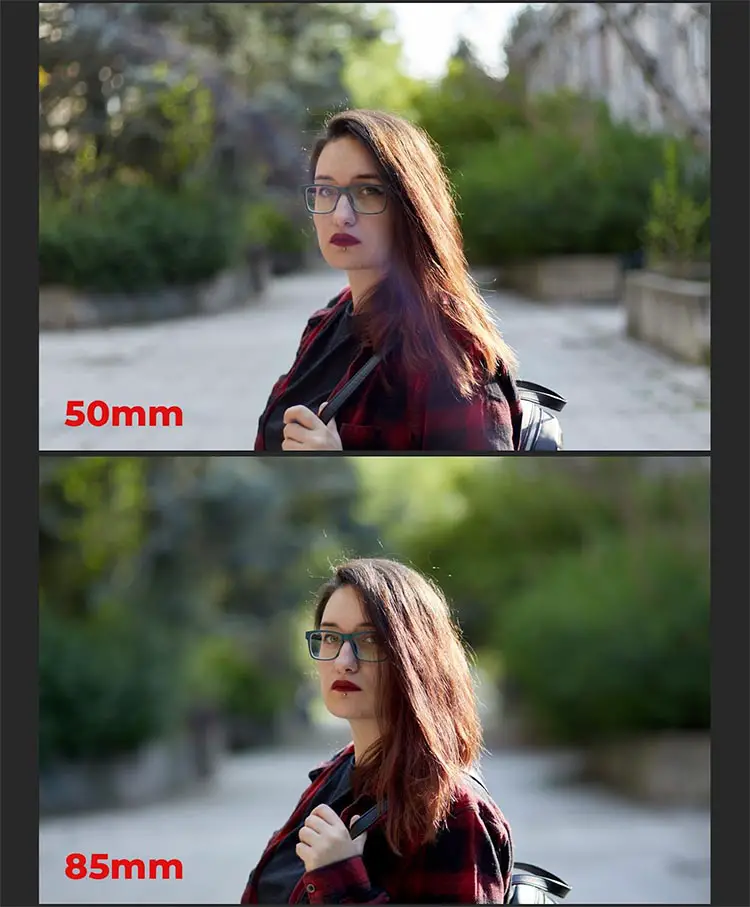
The 85mm lens has a longer focal length than the 50mm, which means the same thing happens as with the 35mm-50mm comparison. In the 85mm photo the background appears closer, and it is blurrier than the background in the 50mm photo. To keep the subject the same size, you will need to increase the distance to the subject with the 85mm, or vice versa.
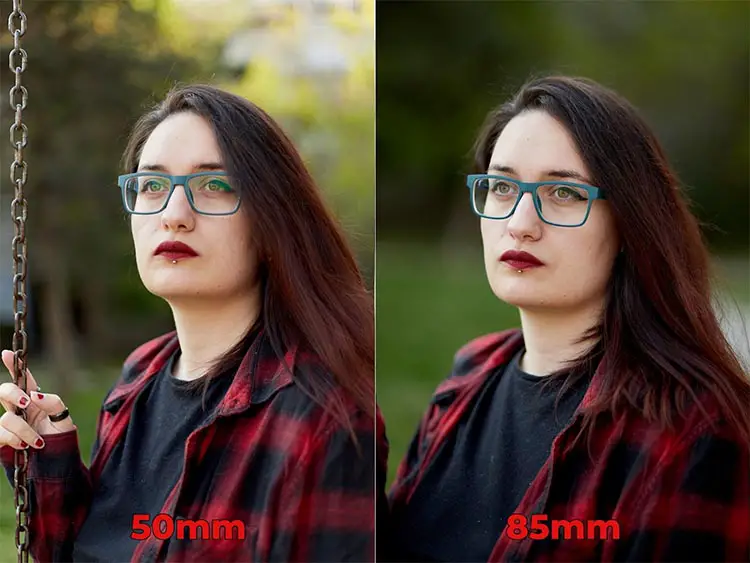
The facial features exaggeration is noticeable at these focal lengths too. However, in this case, the exaggeration does not look unflattering. So at this point, it is a matter of personal preference. Bear in mind that it can also be dependent on the model. Some models look better when photographed with 50mm, while others look better when an 85mm lens is used. It is wise to try both before a photoshoot to see which suits the model better.
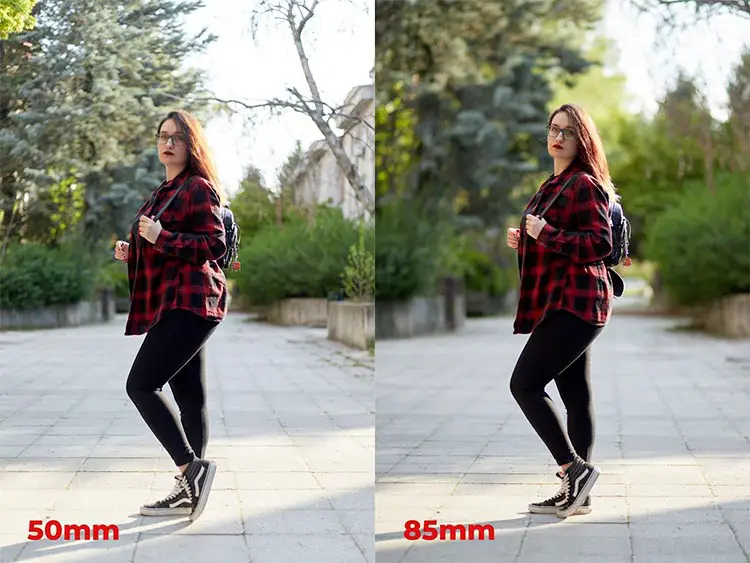
If you were to shoot full-body shots with these two lenses and keep the subject the same, the 85mm lens will compress the background even more than the 50mm already does. That means that the 85mm will have a background that appears closer and blurrier.
35mm vs 85mm
Jumping between a 35mm and a 50mm is not such a big leap, nor, is it jumping from 50mm to 85mm. But, if you shot two photos, one with an 85mm lens and the other with a 35mm lens, you will realize that they are very, very different lenses.
For portraits, the 85mm compresses the background significantly more than the 35mm lens, resulting in two very different pictures. This occurs regardless of the type of portrait.
For example, in a standard portrait shot without moving the subject, the difference in lenses almost feels as if the portraits have been taken in two different locations.
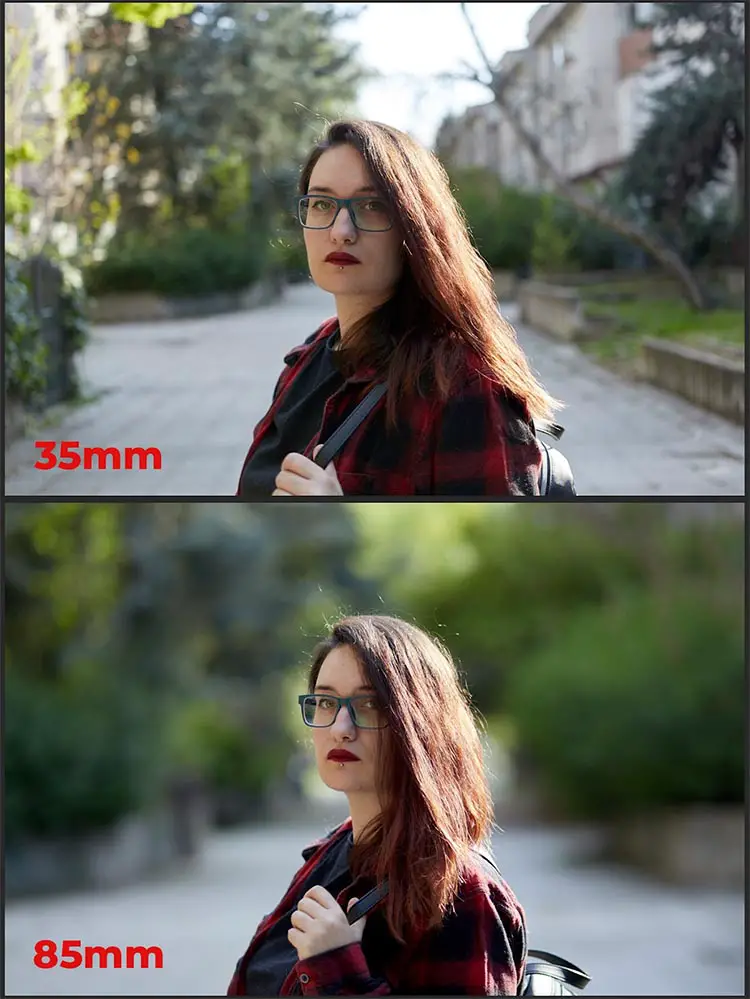
For street photography, the difference is just as staggering. The 35mm lens shows a lot more of the scene, while the 85mm lens isolates the subject more. That means that the 35mm lens is the better choice if you need a lot of the background to tell the story.
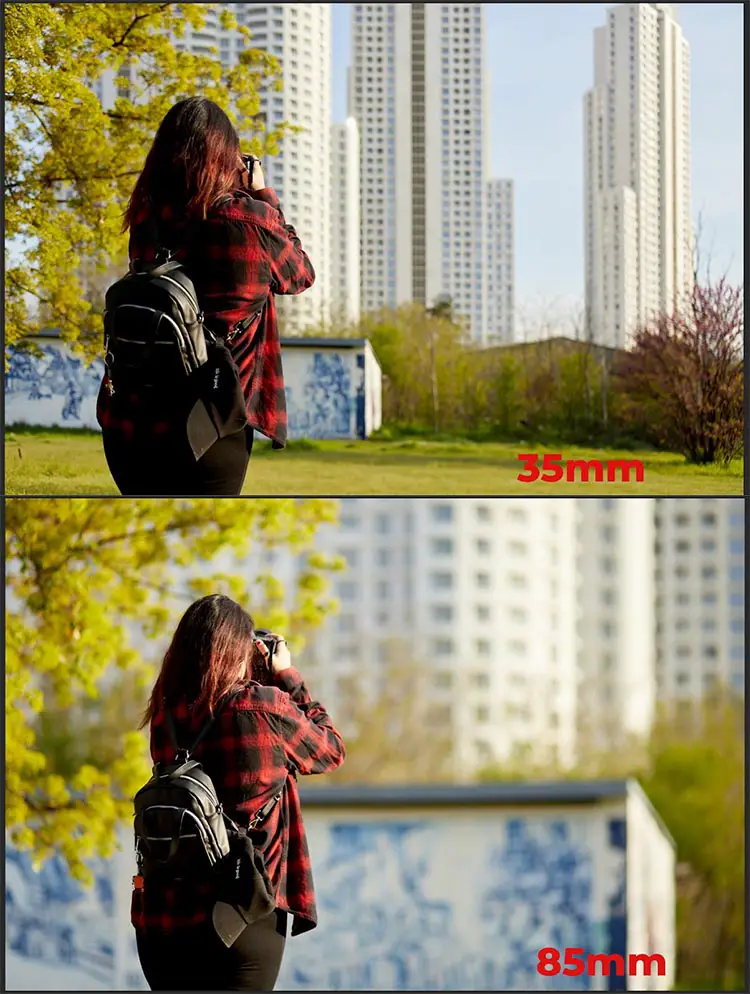
If you need to simplify the background, so the photo is not that complex and yet tells the same story, the 85mm lens is a better choice. The ability to compress the background puts the 85mm ahead in scenarios like this. Granted, if you have the room to use it.
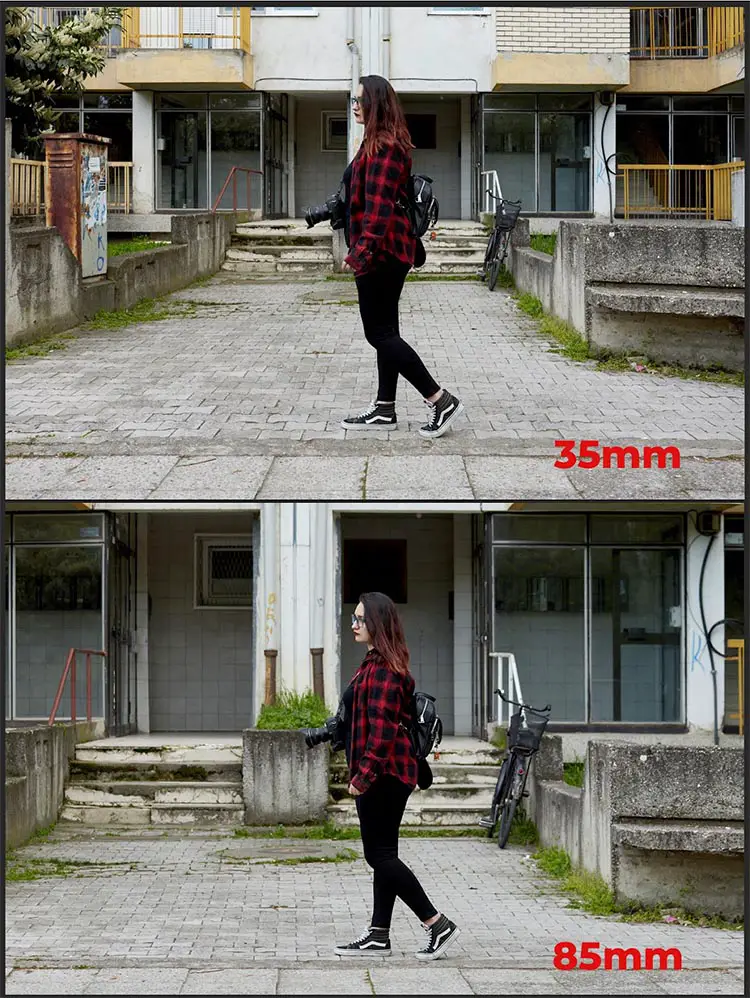
If you are shooting landscapes a 35mm lens can not replace an 85mm lens. If you are creative enough and don’t have issues with stitching panoramas, an 85mm lens can somewhat replace a 35mm lens. But that is not a safe bet. There is no clear winner here.
In my opinion, when it comes to landscapes, you probably would need both.
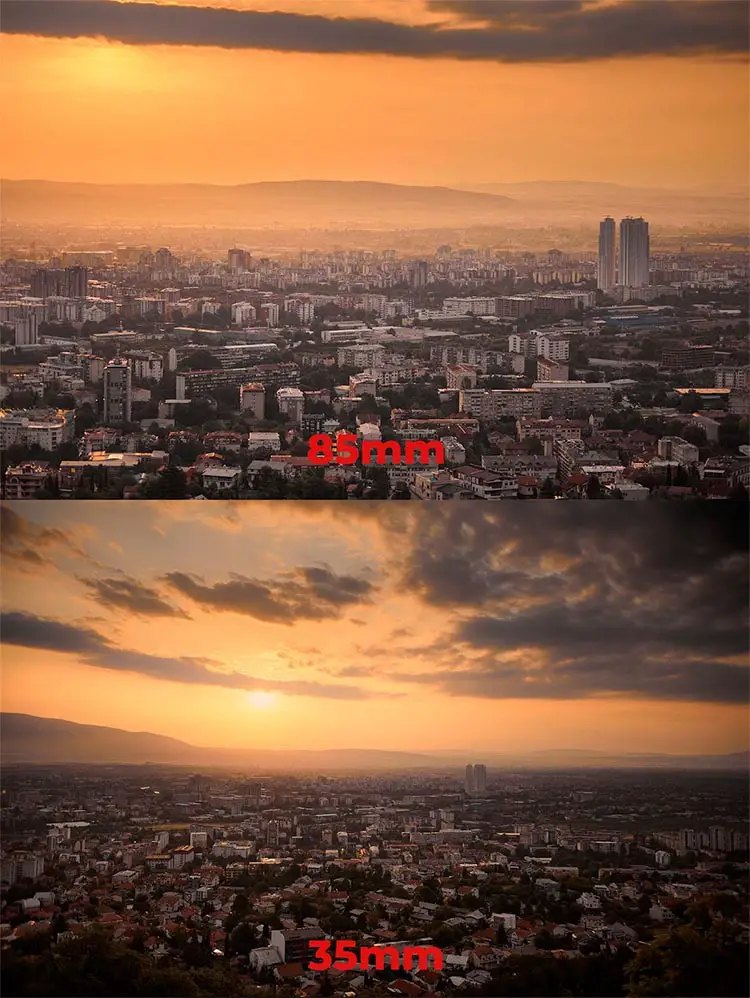
35mm vs 50mm vs 85mm Pros and Cons
So, we’ve looked in detail at the 35mm vs 50mm vs 85mm focal lengths. Overall, each lens serves its purpose, with no one lens any better than any other, unless you need a very specfic purpose like a closeup portrait, or a wide landscape shot.
If you’re still not sure of the ideal focal length for your photography, then take a look at zoom lenses for a way to have all three in one lens.
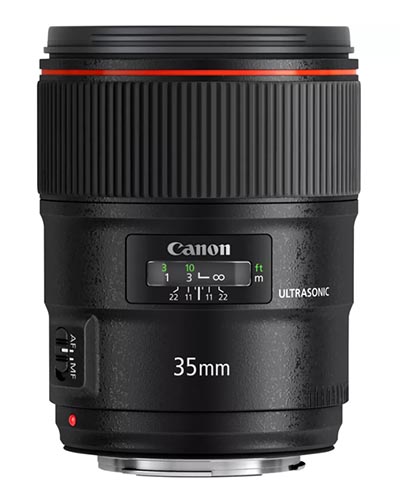
35mm Pros
- Wide angle of view.
- Great for environmental portraits.
- Great for group shots on weddings and ceremonies.
- Great for lifestyle photography due to wider field of view.
- Good for landscapes due to wider field of view.
- Great for street photography if you want a lot of background in frame.
- Great for low light due to the ability to use low shutter speeds of 1/60th of a second.
- Available with wide apertures at low prices.
35mm Cons
- Not good for classic portraits due to exaggeration.
- Not good for classic portraits due to lack of background separation.
- Not good for full body shots due to body elongation and lack of background separation.
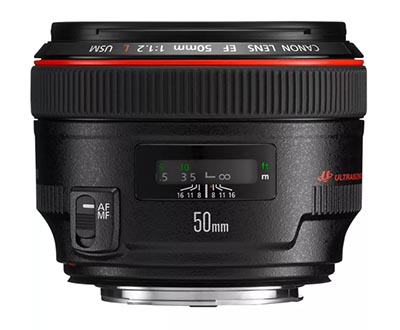
50mm Pros
- Good all around lens. In between the 85mm and the 35mm.
- Natural field of view. Not too wide, not too telephoto.
- Good for environmental portraits.
- Great for street photography.
- Great choice for weddings and ceremonies when you want to separate the subject.
- Good for low light due to the ability to use low shutter speeds of 1/100 of a second.
- Decent for landscapes.
- Good at avoiding unflattering exaggeration.
- Available with wide apertures at the lowest prices.
50mm Cons
- Middle ground lens, not wide, not telephoto.
- Not great for caprutring groups of people at weddings and ceremonies.
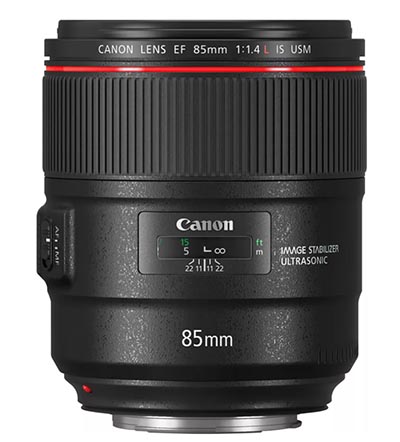
85mm Pros
- Great for portraits that require background separation.
- Great for full body shots.
- Great for avoiding busy backgrounds due to background blur.
- Great for separating the subject in street photography.
- Great for wedding photoshoots and separating subjects on weddings and ceremonies.
- Great for candid street photography due to distance to the subject.
- Great for landscapes where you need to shoot a specific segment of the landscape.
- Great at avoiding unflattering exaggeration.
- Decent for low light due to the ability to use low shutter speeds of 1/160 of a second.
- Available with wide apertures at decent prices.
85mm Cons
- Hard to manage in tight spaces.
- Not good at environmental portraits due to background separation.
- Hard to capture everything in focus or nearly in focus. Unless it is focused at infinity.
- Low margin for focus errors. Mistakes are exaggerated.
- Not great for communication with the subject at photoshoots due to distance to the subject.
- Harder to get clean street photography shots due to the distance to subject.
Read More:
What’s the best 85mm lens for Canon?
24mm vs 35mm lens comparison (with examples)
35mm vs 28mm focal length comparison
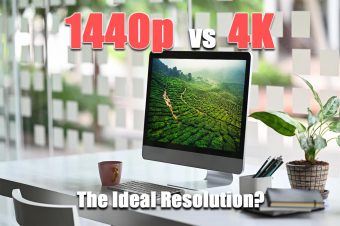



![[SOLVED] How to Turn On Vizio TV Without Remote](https://www.lapseoftheshutter.com/wp-content/uploads/2022/04/how-to-turn-on-vizio-tv-without-remote-340x226.jpg)
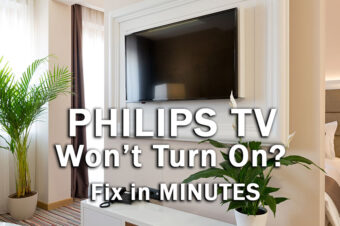
Leave a Reply